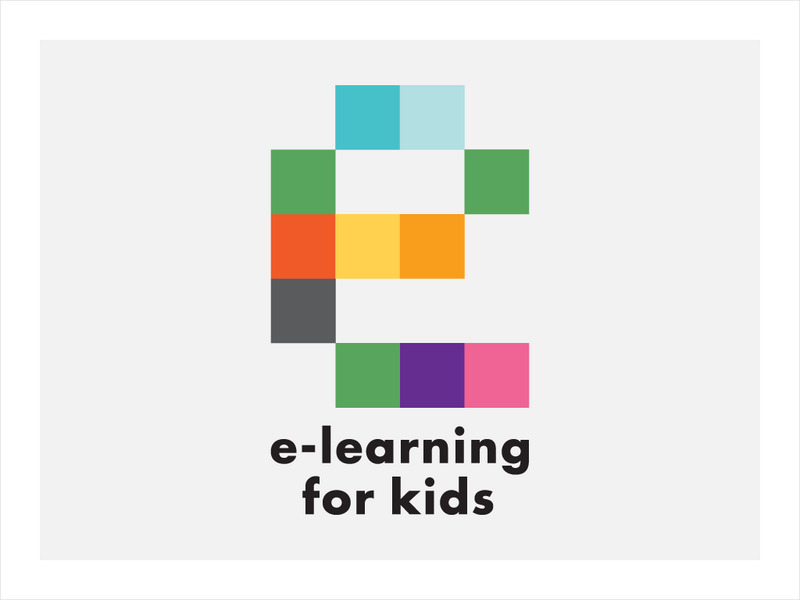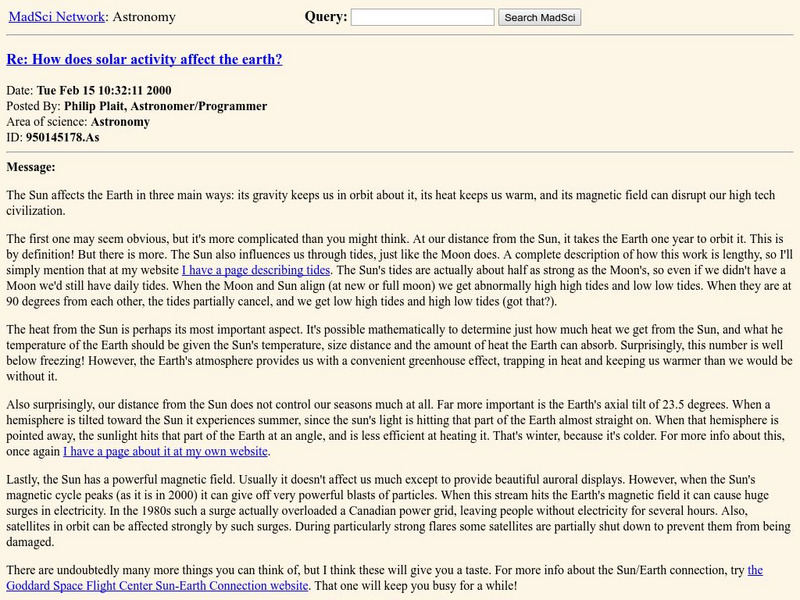Hi, what do you want to do?
Curated OER
Going Through A Phase
Students are introduced to remote sensing equipment used to gather information about the moon. They learn basic facts about the moon such as size, landforms, temperature and gravitational influence on the earth's tides.
Curated OER
How Often?
In this social studies worksheet, learners answer 24 questions about a variety of social studies questions. Students are divided up into two teams and the first team to answer a question correctly gets a point.
Curated OER
Scientist Tracking Network
Learners correlate surface radiation with mean surface temperature of several geographic regions. They observe how these parameters change with latitude and construct an understanding of the relationship of solar radiation to seasonal...
Curated OER
Our Universe: Always Moving, Always Changing
Students explore the main concepts of astronomy through the eleven lessons of this unit. The past, present, and future methods of studying the science are examined in this unit.
Curated OER
Ocean in Motion
In this ocean in motion worksheet, students complete a crossword puzzle given 21 clues about waves, currents, the tides, winds, and surface water.
Curated OER
Foucault's Pendulum
Students investigate how the motion of the Foucault pendulum proves that the Earth is rotating. They research the Internet about pendulums and conduct an experiment online. They view a multimedia presentation about pendulums and read...
Curated OER
Charting Seasonal Changes
Students research the Earth's patterns of rotation and revolution, create a chart and graph of these patterns and use them to explain the causes of night and day and summer and winter.
Curated OER
Intermediate Matching – Types of Books
In this book genre worksheet, students draw a line from the book type words to their definitions. They match nine words, which include dictionary, cookbook, encyclopedia, and fiction, with the definition that best describes it.
Curated OER
Gravity
Sixth graders explore the characteristics of gravity. They discuss gravity on Earth and then use cereal boxes to research and compare the weight of objects on Earth to the weight of those objects on other planets.
Curated OER
Trees!
Students are introduced to the parts of trees through discussion and participation in learning centers with hands on activities that focus on each part.
Curated OER
Interest Survey
In this science and social studies instructional activity, students complete a survey about their interests. Students check each subject that they are interested in, such as killer whales, Thomas Edison, and magnets.
Curated OER
Explorit's SEASHORE Quiz
In this online interactive seashore quiz worksheet, students respond to 5 multiple choice questions. Students may check their answers for accuracy.
Other
Moon Tides: How the Moon Affects Ocean Tides
Discusses the different kinds of tides, high and low tides, lunar tide facts, questions people have asked about tides, and causes of tides.
Texas Education Agency
Texas Gateway: The Moon Lunar Cycle and Tides
Given models and illustrations, students will identify, demonstrate, and predict the sequence of events in the lunar cycle and relate the position of the moon and sun to their effect on ocean tides.
Georgia Department of Education
Ga Virtual Learning: The Moon
In this interactive tutorial students will explore what it is like on the Moon. Learn why the shape of the Moon seem to change and also about lunar eclipses. Discover why the tide changes twice a day and explore how the cycle of the Moon...
E-learning for Kids
E Learning for Kids: Antarctica Penguins: How Does the Moon Influence the Tide?
This lesson explains how the moon affects tides on Earth and about the different types of tides.
CK-12 Foundation
Ck 12: Earth Science: Tides Study Guide
[Free Registration/Login may be required to access all resource tools.] This study guide summarizes key points about the different types of tides and the Moon's effect on Earth's tides. Includes a few questions to check for understanding.
Harvard University
Harvard University: Eyes on the Sky, Feet on the Ground: The Earth's Moon
In this online textbook, students explore the phases of the moon, the moon's orbit, the origin of the moon, and the tides. Includes numerous inquiry-based activities.
Other
Bad Astronomy/phil Plait: Tides and Why Our Days Are Getting Longer
Why does the Moon always shows the same face to the Earth? Why is the Moon's rotation period the same as the length of time it takes to orbit the Earth? Why are there two tides a day? These questions and more are answered here.
MadSci Network
Mad Scientist: Why High Tide Away From the Moon or Sun?
An excellent and thorough answer to the often asked question about high tide "bulges" on the side of Earth facing away from the Moon or Sun.
Woods Hole Oceanographic Institution
Whoi: What Causes Tides?
The Woods Hole Oceanographic Institute provides an in-depth but easy to read article on the role of the moon and the sun in respect to tides.
Enchanted Learning
Enchanted Learning: Earth's Oceans Tides
This site explains what tides are and the difference between Proxigean Spring Tides, spring tides, and neap tides, and how these are formed. Graphic illustrations are provided.
CK-12 Foundation
Ck 12: Earth Science: Tides
[Free Registration/Login may be required to access all resource tools.] Reveals tidal patterns and that tides are caused by the gravitational attraction of the Sun and Moon to Earth.
Khan Academy
Khan Academy: Codex Leicester: Fossils/mountains, Moon/tides
An excerpt from Leonardo da Vinci's Codex Leicester. Find out how this "Renaissance man" observed the Earth and learned more about tides, moons, and fossils in the mountains.



























